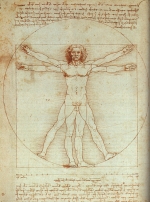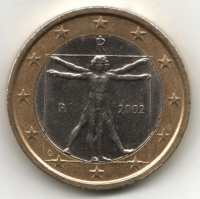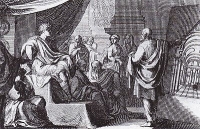


Vitruvius
Vitruvius (fl. 1st century BC) was a Roman architect who worked for both Caesar and Augustus, but the only building he mentions as his own is a basilica at Fanum. Vitruvius does not seem to have had any connection to the major works of his time, and his fame is derived entirely from his treatise De Architectura in ten books, also known by its English title, On Architecture. The De Architectura was probably written between 27 and 23 BC. Vitruvius is unknown to the authors of his day, so virtually everything we know about him must be drawn from the De Architectura. Even his full name is not known with certainty. The words Vitruvii de Architectura head all the most reliable texts, and he is known simply as Vitruvius to Pliny and Frontinus. There is some evidence to suggest his cognomen may have been Pollio, from a single reference in a building manual from the early third century known as De Diversis Fabricis Architectonicae by M. Cetius Faventius. This is far from certain and not universally accepted (Plommer, 1973). The translation could refer to two authors called, the first being Vitruvius and the second Pollio, and not one by the name of Vitruvius Pollio. His praenomen is reported variously as Aulus, Lucius and Marcus. Vitruvius was clearly a freeborn citizen, though probably not of equestrian class. He claims that he was given a broad 'liberal arts' education (book 6) as well as a professional education. His early adult life was probably spent in the military. Indeed, Vitruvius was appointed, after Caesar's death, to be in charge of the construction and repair of catapults (Landels, 2000). This was a responsible position not given lightly, and shines a positive light on Vitruvius.De Architectura is an example of a hybrid type of literature that was common in the last century or the Republic. It is essentially a technical handbook with literary pretensions. Unlike many ancient authors (especially historians), Vitruvius does not denigrate the work of other authors but rather lavishes praise on them. The De Architectura is one of many examples of Latin texts that owe their survival to the palace scriptorium of Charlemagne in the early ninth century - this activity of finding and recopying classical manuscripts is called the Carolingian Renaissance. The mood of the preface is one of the strongest reasons for dating the De Architectura to the decade after Actium (31 BC). Vitruvius states that he is writing at that particular time because Octavian had previously been occupied with "Taking possession of the world". A period of peace had brought about considerable building activity. Vitruvius wrote his text when, as he put it, "I perceived that you were solicitous ... for the construction of suitable buildings". The De Architectura was not the major architectural handbook of its day, but it's clear Vitruvius was hoping it would be. The books themselves are remarkably objective and comprehensive, though prescriptive rather than descriptive. The importance of the De Architectura is twofold. First, it is a rare survivor from a category that was once numerous and important, the technical manual. Secondly, as Vitruvius' definition of an architect is wider than the modern definition, it gives us a good idea of a wide variety of Roman engineering practices. Among interesting concepts contained in the De Architectura, Vitruvius declares that quality depends on the social relevance of the artist's work, not on the form or workmanship of the work itself. Vitruvius studied human proportions (third book) and his system of human proportions were later encoded in a very famous drawing by Leonardo da Vinci (Homo Vitruvianus). Indeed, the De Architectura was very influential in the Renaissance. The 16th century architect Palladio considered Vitruvius his master and guide, and made some drawings based on his. Despite the praise heaped upon Vitruvius' shoulders, it must be recalled that most of the recommendations in the De Architectura were his, and not a true reflection of actual Roman practice.
Hodge (2002:14) states that Book 8, the book that covered water engineering, is perhaps Vitruvius' worst book, and may have been an imperfect summary from other, possibly Greek, sources. It is possible that Vitruvius did not fully understand the material he copied. A reading of Book 8 partially supports Hodge's critique, but it is perhaps unfair to hold Vitruvius to a technical standard so far above that of his contemporaries.
Vitruvius asserted that a structure must exhibit the three qualities of firmitas, utilitas and venustas - that is, it must be strong or durable, useful and beautiful or graceful. The aqueducts, being mostly underground, usually do not exhibit venustas. However, when above ground, they certainly do! However, they perhaps do not show as much firmitas as the Romans would have liked.
According to Plommer (1973:1), two later authors, Palladius Rutilius Taurus Aemilianus and M. Cetus Faventinus, wrote books similar to Vitruvius' books. However, they are mostly derived from Vitruvius; Faventinus directly from Vitruvius and Palladius from Faventinus. Both of these authors contain sections on aqueducts, but lack the grasp of Hellenistic science that Vitruvius had. In both cases their works are technically poorer. Faventius seems to show a decline not only from Hellenistic skills, but also from Roman (Plommer, 1973:29). His addition of wood as a viable material for aqueduct channel construction may also show a difference in the mindsets between Vitruvius' era and Faventinus' era. Vitruvius, living in a more optimistic and vigorous time, advocated building for the long term, while Faventinus seems to have been more pessimistic and focussed on the short-term.
While Palladius can easily be dismissed as a source, Faventinus may reward a careful reading. He was perhaps a more experienced builder than Vitruvius. He certainly seemed to have greater empirical knowledge of some building materials, such as lime (Plommer, 1973:93). However, he seems not to have studied outside his probable area of practical expertise. For example, the laying of mosaic floors had advanced since Vitruvius' time, but Faventinus follows Vitruvius very closely (Plommer, 1973:99). This suggests that Faventinus knew little of the actual craft.
From the thesis of Evan J. Dembskey on The aqueducts of Ancient Rome